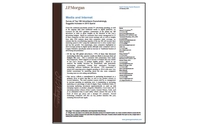
The world’s biggest marketers
overwhelmingly plan to boost their advertising this year, although many of the largest will continue to increase their focus on digital media vs. non-digital media, according to an analysis released
this morning by the equity research team at J.P. Morgan. Describing the results as “encouraging” for the 2015 ad outlook, the J.P. Morgan team based their analysis on comments made by 53
of the global top 100 advertisers during their fourth-quarter 2014 earnings calls.
“The overwhelming majority of the top 100 will increase their marketing spend in 2015 using
this traditional lever to drive market share and top line growth,” the team writes in their equity research report, adding: “Not surprisingly, many companies highlighted an above-average
pickup in digital spend, although some companies such as Colgate Palmolive specifically noted an increase in '‘traditional buckets of advertising and promotion'."
Overall, the
analysts determined that about 75% of the marketers plan to boost their 2015 marketing budgets, and characterized the following categories as “particularly encouraging:” automotive,
beverages, technology, software, healthcare, and telecommunications.
Consumer packaged goods was characterized as “mixed,” which the analysts said was “not
surprising given sluggish spending in 2014” and the fact that some CPG marketers are focusing more on “cost-cutting and pullbacks.”
The analysis indicates only
about 10% of the big marketers are focusing on media cost-cutting.
“A handful of companies are searching for a better return or are proceeding through cost-cutting
initiatives,” the analysts wrote, singling out Merck and Eli Lilly in the pharmaceutical category, General Mills in food, Orange in telecom and Samsung in consumer electronics.
Overall, the marketers are refocusing their mix with an emphasis on digital.
“Native ads and video on smartphones should attract the most new online dollars, with Facebook,
Google, and ultimately Twitter as key beneficiaries,” the equity researchers predict, adding: “We believe that mobile accounts for more than 50% of YouTube watch time and ~75% of overall
views. Facebook also recently noted 3B daily video views, with 65% of them coming through mobile, and Facebook accounts for 21% of total mobile time spent in the US. Twitter, whose advertising
originated more from brand marketers than DR advertisers, will likely become an increasingly important form of engagement for brands given the ability to communicate with consumers in real-time and
now to utilize video more effectively on the platform.”